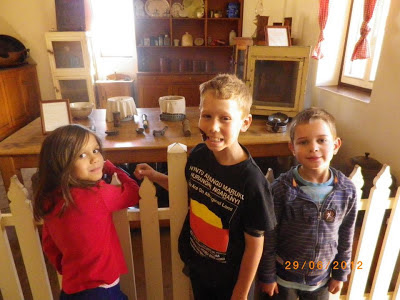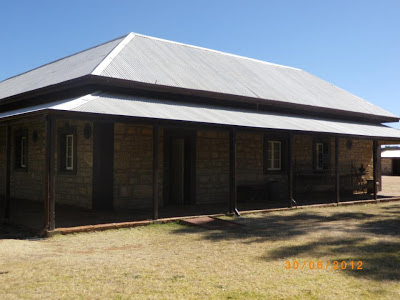In order to know where we are going
we need to know where we've been
Roy C. Owens
Our first day in Alice Springs, Northern Territory was spent at the telegraph station museum and reserve. It is the original site of the first European settlement in Alice Springs. It is also the place of the 'spring' that gave the place its name. It operated as a telegraph station for 60 years before becoming a school for Aboriginal children. This is a nice way of saying a place where they put half-caste children when they took them away from their parents.
But I wanted to understand so I could teach my children a true, historical account that acknowledged the first Australians in a way that traditional curriculum often ommitted.
I won't be teaching my kids in the typical white fella way with the emphasis being on the early pioneers and settlers with the disclaimer, "Oh and kids...those early pioneers weren't very nice to Aboriginal people...but moving on...".
I want my kids to know their history, to understand the beauty of Aboriginal culture and what happened when white people took away their homes and land. I want them to understand the complexities of how this impacted the Aboriginal people and how this is still relevant today.
An exercise in teaching Aboriginal history to small children....
I was encouraged by our friend to teach my kids the heart of the issue when it comes to invasion: land. Land is everything to Aboriginal people. It is part of their identity, their spirituality and their connection to one another. To take away land is to take away their heart and soul and most significantly, their identity.
Step 1.
Take kids into their favourite room (bedroom or playroom) and ask them to tell you everything they love about that space. They will normally describe toys and books and encourage them to try and explain how they feel when they are there e.g safe, happy...
Step 2.
Ask them to imagine that the local council has just sent you a letter informing you that they are building a road through their favourite room and they don't have a choice. Ask the children how that makes them feel and how it would feel to watch someone they don't know take their things and tell them they can't live in their home anymore. Be wise in how you do this if your child is sensitive.
Step 3.
Explain that this is how Aboriginal people feel when their land has been taken away from them. They didn't have a choice and it made them feel really sad. Many Aboriginal people today still feel sad because they grieve for something they lost. When Aboriginal people lost their land, they also lost their connection to their own families, their stories and history.
It is only fair that we validate and respect their experience by sharing the truth with our children.
It is only fair that we validate and respect their experience by sharing the truth with our children.
I did this with my 6 and almost 5 year old as they asked many questions after their visit to the telegraph museum. In fact, DS6 couldn't wait to ask me to explain why the Aboriginal gentleman (pictured above) who showed us around had been taken away from his family and forced to live in the old telegraph station.
I was concerned about my ability to tell him this history in a way that wouldn't freak out his sensitive nature. He surprised me. He comprehended it quite well and acknowledged that it was, "history which means in the past so those things don't happen anymore". I struggled to keep it together while explaining the stolen generation though.
Australia sadly, has a very shameful history (like many countries) and many Australians are unaware of their roots. We've turned a blind eye as many aspects are too confronting. I don't remember learning half of what I know about the first Australians in school. I certainly wasn't taught the full story.
The SBS series the first Australians is an excellent resource for teachers and homeschoolers.
I believe all children need an honest age-appropriate introduction to Australian history, particularly, one that acknowledges the rich culture of those who were here before us.





Comments
Post a Comment